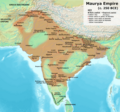Ficheiro:Maurya Empire, c.250 BCE.png

Dimensões desta antevisão: 642 × 600 píxeis. Outras resoluções: 257 × 240 píxeis | 514 × 480 píxeis | 822 × 768 píxeis | 1 200 × 1 121 píxeis.
Imagem numa resolução maior (1 200 × 1 121 píxeis, tamanho: 2,3 MB, tipo MIME: image/png)
Histórico do ficheiro
Clique uma data e hora para ver o ficheiro tal como ele se encontrava nessa altura.
| Data e hora | Miniatura | Dimensões | Utilizador | Comentário | |
|---|---|---|---|---|---|
| atual | 02h15min de 29 de janeiro de 2024 |  | 1 200 × 1 121 (2,3 MB) | Avantiputra7 | as per discussions added labelling of provinces |
| 06h40min de 22 de novembro de 2023 |  | 1 200 × 1 121 (2,06 MB) | Avantiputra7 | Reverted to version as of 05:59, 22 November 2023 (UTC) no justification for changing to less legible version of exactly the same map | |
| 06h14min de 22 de novembro de 2023 |  | 1 500 × 1 309 (2,93 MB) | Indo12122 | Reverted to version as of 05:34, 22 November 2023 (UTC) Stop hijacking. | |
| 05h59min de 22 de novembro de 2023 |  | 1 200 × 1 121 (2,06 MB) | Avantiputra7 | Reverted to version as of 05:06, 22 November 2023 (UTC) | |
| 05h34min de 22 de novembro de 2023 |  | 1 500 × 1 309 (2,93 MB) | Indo12122 | Reverted to version as of 19:00, 21 November 2023 (UTC) | |
| 05h06min de 22 de novembro de 2023 |  | 1 200 × 1 121 (2,06 MB) | Avantiputra7 | Reverted to version as of 18:13, 21 November 2023 (UTC) rv vandalism | |
| 19h00min de 21 de novembro de 2023 |  | 1 500 × 1 309 (2,93 MB) | Indo12122 | Reverted to version as of 17:53, 21 November 2023 (UTC) Adding Gedrosia .Ray, Himanshu Prabha (2003). The Archaeology of Seafaring in Ancient South Asia. Cambridge University Press. ISBN 978-0-521-01109-9. In spite of the vagueness of the historical texts, the consensus among scholars is that the treaty concluded between Candragupta Maurya and Seleucus acknowledged Indian control of territories to the west of the Indus. These included Gedrosia, Paropamisadae (the region of Kabul and Begram) a... | |
| 18h13min de 21 de novembro de 2023 |  | 1 200 × 1 121 (2,06 MB) | Avantiputra7 | Reverted to version as of 17:07, 21 November 2023 (UTC) no justification for changing to less legible version of exactly the same map | |
| 17h53min de 21 de novembro de 2023 |  | 1 500 × 1 309 (2,93 MB) | Indo12122 | Reverted to version as of 16:58, 21 November 2023 (UTC) | |
| 17h07min de 21 de novembro de 2023 |  | 1 200 × 1 121 (2,06 MB) | Avantiputra7 | Reverted to version as of 16:36, 21 November 2023 (UTC) |
Utilização local do ficheiro
Não há nenhuma página que use este ficheiro.
Utilização global do ficheiro
As seguintes wikis usam este ficheiro:
- en.wikipedia.org
- en.wiktionary.org
- hy.wikipedia.org
- ko.wikipedia.org
- sv.wikipedia.org
- ta.wikipedia.org
- zh.wikipedia.org
